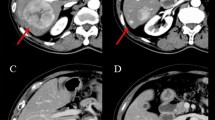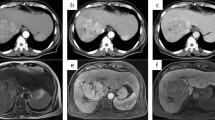Abstract
We herein report two cases of huge hepatocellular carcinoma (HCC) that were successfully treated by carbon ion radiotherapy after atezolizumab plus bevacizumab treatment. Case 1, an 84-year-old man, was diagnosed with HCC (maximum diameter: 11 cm) with portal invasion and presented HCC rupture. After obtaining hemostasis with transcatheter embolization, three cycles of atezolizumab-bevacizumab therapy were administered, and marked shrinkage of the HCC was confirmed. However, he developed jaundice, liver damage and cerebral subcortical hemorrhage. Thus, atezolizumab-bevacizumab therapy was discontinued. Total bilirubin, transaminase levels, and physical activity improved well with prednisolone, an antihypertensive agent, and rehabilitation. Thus, treatment with carbon ion radiotherapy (CIRT) was added, and the treatment effect at 4 months after CIRT was judged as a complete response (CR) according to the modified response evaluation criteria in solid tumors (mRECIST). Case 2, a 68-year-old man, was diagnosed with HCC (maximum diameter: 14 cm). Hepatic resection was difficult because the residual liver volume after treatment would be insufficient. Five cycles of atezolizumab-bevacizumab therapy were performed, and marked shrinkage of the HCC to a maximum diameter of 9 cm was confirmed. The treatment was converted to CIRT, and atezolizumab-bevacizumab therapy resumed one month after CIRT. The treatment effect at 3 months after CIRT was judged as CR according to mRECIST. Although conversion therapy after atezolizumab-bevacizumab therapy, including surgery and radiofrequency ablation, have been reported, CIRT may be a promising new tool for conversion therapy for HCC.




Similar content being viewed by others
References
Heimbach JK, Kulik LM, Finn RS, et al. AASLD guidelines for the treatment of hepatocellular carcinoma. Hepatology. 2018;67:358–80.
Ikai I, Arii S, Okazaki M, et al. Report of the 17th nationwide follow-up survey of primary liver cancer in Japan. Hepatol Res. 2007;37:676–91.
Mulcahy MF. Management of hepatocellular cancer. Curr Opin Oncol. 2005;6:423–35.
Kuvshinoff BW, Ota DM. Radiofrequency ablation of liver tumors: influence of technique and tumor size. Surgery. 2002;132:605–11.
Shiina S, Teratani T, Obi S, et al. A randomized controlled trial of radiofrequency ablation with ethanol injection for small hepatocellular carcinoma. Gastroenterology. 2005;129:122–30.
European Association for the Study of the Liver. Electronic address: easloffice@easloffice.eu; European Association for the Study of the Liver. EASL clinical practice guidelines: Management of hepatocellular carcinoma. J Hepatol. 2018; 69: 182–236.
Finn RS, Qin S, Ikeda M, et al. Atezolizumab plus bevacizumab in unresectable hepatocellular carcinoma. N Engl J Med. 2020;382:1894–905.
Kudo M. A novel treatment strategy for patients with intermediate-stage HCC who are not suitable for TACE: Upfront systemic therapy followed by curative conversion. Liver Cancer. 2021;10:539–44.
Apisarnthanarax S, Bowen SR, Combs SE. Proton beam therapy and carbon ion radiotherapy for hepatocellular carcinoma. Semin Radiat Oncol. 2018;28:309–20.
Reig M, Forner A, Rimola J, et al. BCLC strategy for prognosis prediction and treatment recommendation: the 2022 update. J Hepatol. 2022;76:681–93.
Shindoh J, Kawamura Y, Kobayashi Y, et al. Prognostic impact of surgical intervention after lenvatinib treatment for advanced hepatocellular carcinoma. Ann Surg Oncol. 2021;28:7663–72.
Hoshino T, Naganuma A, Furusawa A, et al. A case of conversion hepatectomy for huge hepatocellular carcinoma with adrenal metastasis and vascular invasion after atezolizumab-bevacizumab treatment. Clin J Gastroenterol. 2022;15:776–83.
Kudo M. Changing the treatment paradigm for hepatocellular carcinoma using atezolizumab plus bevacizumab combination therapy. Cancers. 2021;13:5475.
Shiba S, Shibuya K, Okamoto M, et al. Clinical impact of hypofractionated carbon ion radiotherapy on locally advanced hepatocellular carcinoma. Radiat Oncol. 2020;15:195.
Hack SP, Spahn J, Chen M, et al. IMbrave 050: a phase III trial of atezolizumab plus bevacizumab in high-risk hepatocellular carcinoma after curative resection or ablation. Future Oncol. 2020;16:975–89.
Shibuya K, Katoh H, Koyama Y, et al. Efficacy and safety of 4 fractions of carbon-ion radiation therapy for hepatocellular carcinoma: a prospective study. Liver Cancer. 2021;11:61–74.
Lim KC, Chow PK, Allen JC, et al. Systematic review of outcomes of liver resection for early hepatocellular carcinoma within the milan criteria. Br J Surg. 2012;99:1622–9.
Mole RH. Whole body irradiation; radiobiology or medicine? Br J Radiol. 1953;26:234–41.
Ohmatsu K, Hashimoto Y, Kawanishi M, et al. Abscopal complete regression of hepatocellular carcinoma with multiple pleural metastases. Int Cancer Conf J. 2020;10:54–8.
Nakanishi M, Chuma M, Hige S, et al. Abscopal effect on hepatocellular carcinoma. Am J Gastroenterol. 2008;103:1320–1.
Helm A, Ebner DK, Tinganelli W, et al. Combining heavy-ion therapy with immunotherapy: an update onrecent developments. Int J Part Ther. 2018;5:84–93.
Helm A, Tinganelli W, Simoniello P, et al. Reduction of lung metastases in a mouse osteosarcoma model treated with carbon ions and immune checkpoint inhibitors. Int J Radiat Oncol Biol Phys. 2021;109:594–602.
Zhang H, Huang Z, Zou X, Liu T. Bevacizumab and wound-healing complications: a systematic review and meta-analysis of randomized controlled trials. Oncotarget. 2016;7:82473–81.
Aussilhou B, Dokmak S, Faivre S, et al. J. Preoperative liver hypertrophy induced by portal flow occlusion before major hepatic resection for colorectal metastases can be impaired by bevacizumab. Ann Surg Oncol. 2009;16(6):1553–9.
Lu JF, Bruno R, Eppler S, et al. Clinical pharmacokinetics of bevacizumab in patients with solid tumors. Cancer Chemother Pharmacol. 2008;62:779–86.
Yoshida M, Ogino H, Iwata H, et al. Transient increases in serum α fetoprotein and protein induced by vitamin K antagonist II levels following proton therapy does not necessarily indicate progression of hepatocellular carcinoma. Oncol Lett. 2019;17:3026–34.
Yu R, Tan Z, Xiang X, et al. Effectiveness of PIVKA-II in the detection of hepatocellular carcinoma based on real-world clinical data. BMC Cancer. 2017;17:608.
Sorin Y, Ikeda K, Kawamura Y, et al. Effectiveness of particle radiotherapy in various stages of hepatocellular carcinoma: a pilot study. Liver Cancer. 2018;7:323–34.
Author information
Authors and Affiliations
Corresponding authors
Ethics declarations
Conflict of interest
The authors declare no conflicts of interest in association with the present study.
Human and animal rights
All procedures followed have been performed in accordance with the ethical standards laid down in the 1964 Declaration of Helsinki and its later amendments.
Informed consent
The written informed consent was obtained from patients for this case report.
Additional information
Publisher's Note
Springer Nature remains neutral with regard to jurisdictional claims in published maps and institutional affiliations.
Rights and permissions
Springer Nature or its licensor (e.g. a society or other partner) holds exclusive rights to this article under a publishing agreement with the author(s) or other rightsholder(s); author self-archiving of the accepted manuscript version of this article is solely governed by the terms of such publishing agreement and applicable law.
About this article
Cite this article
Takakusagi, S., Tanaka, H., Naganuma, A. et al. Two cases of hepatocellular carcinoma successfully treated by carbon ion radiotherapy after atezolizumab plus bevacizumab treatment. Clin J Gastroenterol 16, 407–415 (2023). https://doi.org/10.1007/s12328-023-01768-z
Received:
Accepted:
Published:
Issue Date:
DOI: https://doi.org/10.1007/s12328-023-01768-z




